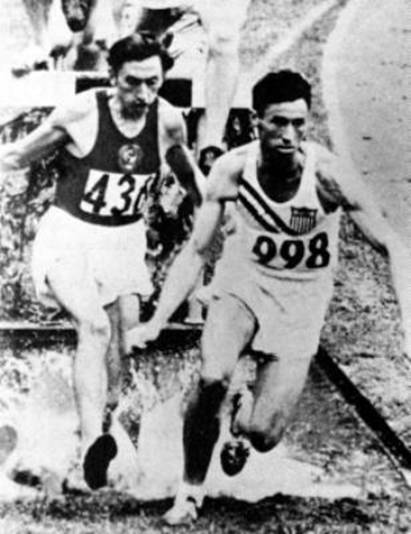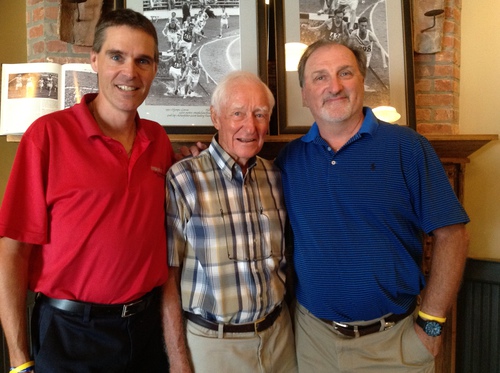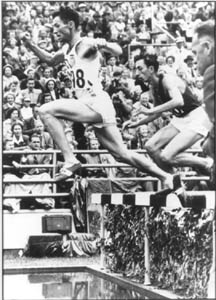1952 Olympic steeple final, Horace Ashenfelter,
courtesy of Ashenfelter Classic 8k
Originally posted August 22, 2012
Reposted January 7, 2018
Horace Ashenfelter died on January 6, 2018, at the wonderful age of 94. Horace Ashenfelter won the Olympic steeplechase in 1952, the first and last American male to do such an thing. In his honor, we are reposting several pieces on this wonderful man, classmate of our late editor, James Dunaway, and former FBI agent, Penn State grad, and winner of 18 AAU national titles, from cross country to 10k.
Horace Ashenfelter’s name should be said with reverence. The only American to win the Olympic gold medal in the steeplechase, Ashenfelter broke the Olympic record in the heats and then by six seconds, broke the world record in the final, taking the gold medal.
In a 1996 article in American Track & Field, James Dunaway, long time editor of AT&F, and college chum of Horace, wrote, what in my mind, may still be Dunaways’ best feature ever. He told how Horace would train for an hour each night, after work, jumping over park benches, doing 880 repeats, but finding way to be world class, be a husband and father and keep his career in the FBI. No mean feat in those days.
Now 89, Horace Ashenfelter was inducted into the National Distance Running Hall of Fame this past month. Runblogrun writer and American Track & Field long time correspondent Jeff Benjamin was there and here is his piece.
Our friend Jeff was injured in a recent bike crash, so keep him in your thoughts and prayers.
Jeff Benjamin (the writer), Horace Ashenfelter (1952 Olympic gold), Tom Fleming (two time NYC Marathon winner),
“When I was kid and I heard there was an Olympic Champion living in New Jersey not too far away, I went over there to meet him. We’ve been friends ever since!” was how Tom Fleming first met Horace Ashenfelter.
Jeff Benjamin concluded with this note: “My sincere thanks for being invited to this ceremony by Tom Fleming and Mary MacEnroe of the National Distance Running Hall of Fame, and for the wonderful atmosphere provided by Paul Brewster, the owner of Fitzgerald’s 1928 in Glenn Ridge, which hosted this great event!!!”
When Horace and Lillian Ashenfelter arrived at Fitzgerald’s 1928 Restaurant in Glenn Ridge, New Jersey on the 60th anniversary of his Gold Medal and World Record performance to be inducted into the National Distance Running Hall of Fame, he reminisced not only about his 1952 Helsinki Olympic performance and other athletic exploits but also his fears. “When our team arrived in Finland, we had to take a train to Helsinki,” the 89 year old legend remembered. “Our windows were painted black because we were travelling through a Soviet-Occupied area and we feared we’d be hit!”
This was no hollow statement. 1952 was one of the “hottest” years of the U.S.-Soviet Cold War. Fear of nuclear holocaust, Mcarthyism and the Korean War all were on the minds of billions, including the Olympic Athletes. “Everyone knew what was going on, that there were conflicts going on between the two countries,” said Ashenfelter. Then he pointedly stated, “But NOT between the athletes!”
Horace Ashenfelter, competing in the 3000 meter steeplechase, was a true underdog. The greatest steepler of the time, Soviet athlete Vladimir Kazantsev was the overwhelming favorite. However, in a previous interview Ashenfelter stated, ” I didn’t even consider that I was the underdog…I was there to represent the United States, do my best and that was it.”
Horace Ashenfelter, 1952 Olympic final, photo courtesy of Ashenfelter Classic 8k
When he surprised many by setting the Olympic record in his Semi-final (8:51.00), the Soviets, who were competing in their first Olympic Games, instructed Kazantsev to run on Ashenfelter’s right side, forcing the Soviet to run extra steps, which suited Ashenfelter just fine. “I knew I was going to win,” Ashenfelter said modestly, as if it was just a fact. In the perceptions of the time, it was also noted that Ashenfelter worked for the FBI, while Kazantsev had some sort of KGB connections, a fact that fit nicely right into the Cold War category!!
Neck and neck entering the final lap, Lillian Ashenfelter, sitting in the stands, decided to close her eyes until she heard lowd cries from the crowd, which would indicate the race was over. At the final water barrier, Kazantsev jumped straight down into the water, while Ashenfelter leaped angularly, pretty much clearing most of the water and launching a furious sprint and finishing in a new world record of 8 minutes, 45.4 seconds, a world record and nearly 6 seconds in front of Kazantsev and a delirious crowd, along with an open-eyed happy Lillian!!
The Olympic Champion returned home to Glenn Ridge a national hero, and he would continue to break world records for the indoor two-mile. From 1952 to 1956 he was the indoor three-mile champion. He also won a silver medal in the 1955 Pan-American games along with many AAU titles. Then, in 1957, at age 35, he announced his retirement from competitive running. Now 89, he still gets out to jog and a local Thanksgiving tradition, the Ashenfelter 8k Race, continues to be run by thousands to this day in Glenn Ridge every year!!
Jeff Benjamin has written for 30 years for American Track and Field along with RunBlogRun. The Former President of the Staten Island AC & Chair of the Staten Island Running Association was the 5th man scorer for his Susan Wagner High School NYC XC City Championship team. Also a member of the College of Staten Island Sports Hall of Fame for XC, Jeff currently serves as the LDR Chairman for USATF NY. A passionate (or fanatical) follower of the Sport, some of Jeff's subjects have included Sebastian Coe, Emma Coburn, Eamonn Coghlan, Matt Centrowitz, Jim Spivey, Galen Rupp, Joe Newton, Tom Fleming, Ajee’ Wilson, Bill Rodgers, Allan Webb, Abel Kiviat, Jordan Hassay, Marty Liquori, Caster Semenya, Rod Dixon, Carl Lewis and Jim Ryun as well as Book Reviews and articles covering meets and races in the Northeast U.S.
View all posts
























